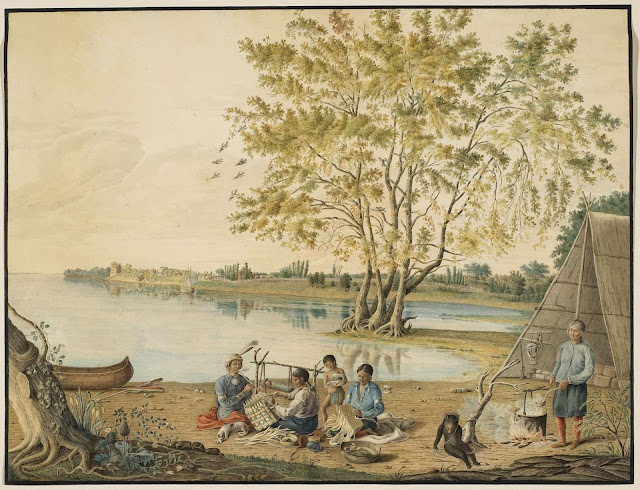Just completed another display paddle for the upcoming
WCHA Assembly in Peterborough this summer. My presentation on Saturday July 21 will focus on decorative themes featured in various artworks over the centuries. One such pattern that consistently occurs in several artworks is the "checkerboard" pattern where the blade is painted in opposite quadrants, sometimes with additional decorative elements.
The earliest painting illustrating this pattern I could source is by British Artist, Thomas Davies (1737 - 1812). His painting entitled
A View near Point Levy opposite Quebec.. is dated to 1788 and features a standing figure holding a short canoe paddle decorated an alternating red pattern. The native group is thought to be Abenaki or Huron / Wendat based on the canoe designs and clothing.
A View near Point Levy opposite Quebec with an Indian Encampment, Taken in 1788 (1788 )
Thomas Davies (1737 - 1812)
Davies' Paddle Closeup
Decades later the red checkered pattern appears on a work by William Bent Berczy (1791 – 1873) entitled
Indian Encampment near Amherstburg features a stylized shore scene. In the rear is a bark canoe and a set of decorated paddles lying on the ground.
Indian Encampment near Amherstburg, c. 1819-1830
William Bent Berczy
British, Canadian, 1791 - 1873
watercolour over graphite on wove paper
A closeup reveals that one paddle looks to have a single side painted red while the one underneath has the diagonal checkered pattern with red paint. Given that the paddle grip was not depicted in the earlier work by Davies, I ended up using Berczy's illustration as the source for my reproduction.
Berczy
Painted Paddle's Closeup
Then 30+ years later, the decorative element occurs again in multiple works of
William Armstrong.

Hudson's Bay Store, Fort William c. 1860-1870
William Armstrong
National Gallery of Canada (no. 30490)
Indians Completing a Portage
William Armstrong
1873 watercolor
Paddle Closeup (far right corner of original image)
The Distribution of the Government Bounty on Great Manitouling Island 1856
William Armstrong
Paddle Closeup (bottom left corner of original image)
Echoing the images portraying rather short paddles, I carved this one from an offcut of basswood. In the end it has a 21 inch blade and an overall length of 4 feet, making it quite suitable for one of my sons to use. It has a blunt, flattened grip as in the Berczy painting. On one side, I included the additional dot element from Davies' work in 1788 and on the other painted the simple checkered pattern found in later artworks of Armstrong.
Paddle Reproduction from Davies, Berczy and Armstrong



























